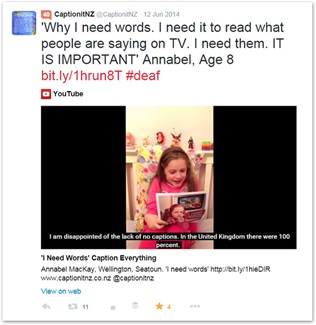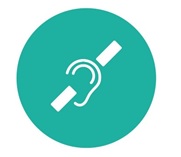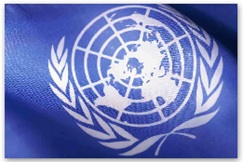New Zealand Web Accessibility & Closed Captioning: Laws, Standards, & Trends
Updated: May 1, 2020
Every New Zealander deserves equal access to media content. There are over 800,000 Kiwis living with hearing loss, or 1 out of 6 people, who don’t have adequate and consistent access to news, sporting events, television shows, and movies like their hearing counterparts.
New Zealand lags behind other English-speaking countries like The United States, The United Kingdom, and Australia in broadcast captioning regulations. Although there is no current legislation in place for providing closed captions, it is required by law.
The National Foundation for the Deaf is campaigning for legislative change in order to make captions mandatory for all TV and on-demand services. The Chief Executive of the foundation, Natasha Gallardo, is dedicated to making captioning a priority for New Zealand media.
As of August 2016, New Zealand’s government has added closed captions to Parliament TV in an effort to increase accessibility.
The move follows a pattern of increased commitment to closed captioning at a national level. Pressured by advocacy from the New Zealand Captioning Working Group, Broadcasting Minister, Amy Adams, promised more captioning for Prime TV, a national free-to-air channel (comparable to BBC or PBS).
Parliament TV (PTV) is a national network devoted to broadcasting live footage of the New Zealand Parliament sessions, similar to C-Span in the United States.
Closed captions are necessary to make television accessible to people who can’t hear, and without it, a segment of the population misses out on important news and entertainment information. Read on for a brief summary of closed captioning rules, recommendations, and trends in New Zealand, or download our white paper on web accessibility and captioning in New Zealand & Australia.
Overview
While New Zealand closed captioning regulations have some catching up to do to match other English-speaking nations, both government and independent groups are committed to video accessibility. Kiwi accessibility advocates are mounting pressure on broadcasters for more comprehensive captioning of TV, movies, and web video.
New Zealand Government Web Accessibility Standard
As of July 1, 2013, the federal government of New Zealand adheres to both an official Web Accessibility Standard and a Web Usability Standard, which mostly follow WCAG 2.0 AA. These standards set inclusive web design requirements for all Public Service departments and Non-Public Service departments in the State Services. The State Services Commission website lists all applicable departments.
The Web Accessibility Standard offers a 4-phased approach, with all New Zealand government websites complying by July 1, 2017.
| Phases | Public Gov’t Websites | Internal Gov’t Websites |
|---|---|---|
| Phase 1: July 2013- June 2014 | Every home page
Every “contact us” (or similar) page Every page delivering high-stakes information or services |
N/A |
| Phase 2: July 2014- June 2015 | All content listed above, plus:
Top 25% most visited web pages delivering core information or services Every webpage created since July 1, 2014 |
Every web page created, redesigned, or redeveloped since July 1, 2014 |
| Phase 3: July 2015- June 2016 | All content listed above, plus:
Top 50% most visited web pages delivering core information or services |
Every web page created, redesigned, or redeveloped since July 1, 2014 |
| Phase 4: July 2016- June 2017 | All web pages | Every web page created, redesigned, or redeveloped since July 1, 2014 |
WCAG Standards for Web Video and Captioning
Web video must be WCAG 2.0 A compliant, requiring closed captions for prerecorded content with a grace period of 10 business days. Live captioning is required for “high stakes information or services,” such as public safety announcements or election news.
New Zealand Broadcast Media Captioning Rules
Approximately 31% of Free to Air New Zealand TV is captioned. A 2015 press release from the CWG observed:
While closed captioning for broadcast TV is not mandated by any New Zealand regulatory body, the Captioning Working Group argues for captioning as a civil right for deaf citizens.
NZ On Air
Governed by appointees of the Minister of Broadcasting, NZ On Air is a federal funding agency that invests in local TV, radio, and digital broadcasting. In their 2013 annual report, they describe their video accessibility efforts:
NZ On Air formed Able, an official closed caption and audio description provider for New Zealand programming. Able provides partial closed captioning to programs on TV ONE, TV2, TV3, TV3 plus 1, FOUR, TV ONE plus 1, TVNZ Heartland and some Sky channels, but there is much more work to be done to make all Kiwi broadcasting accessible.
Human Rights Act Amendment (2001)
New Zealand’s comprehensive anti-discrimination law, the Human Rights Act of 1993, was amended in 2001 to prohibit discrimination on the basis of disability. However, accommodations for deaf or hard of hearing people are not addressed specifically. This doesn’t sit well with disability advocates in New Zealand. They look to a different authority for guidance: the United Nations.
The United Nations Convention on Rights of Persons with Disabilities (CRPD)
The Convention is an international treaty that is recognized by affiliated countries to ensure the rights of people with disabilities. New Zealand ratified the Convention in 2008.
Article 9 recognizes the rights of disabled people to access information and services on the web, TV, or any other form of communication. What does that mean for the country’s disability law? “By ratifying a convention,” the UN explains on its website, “and after the treaty comes into force, a country accepts its legal obligations under the treaty and will adopt implementing legislation.”
….
States Parties shall also take appropriate measures to:…Promote access for persons with disabilities to new information and communications technologies and systems, including the Internet;
Thus, New Zealand observes the UN’s disability rights standards for making web content accessible to the deaf and hard of hearing.
New Zealand Disability Strategy
Published by the Office for Disability Issues, the New Zealand Disability Strategy is a high-level manifesto on the values of inclusion for disabled Kiwis. While it cites objectives for equal access to education, communication, and entertainment, it makes no direct references to video accessibility or transcription. This document is aspirational and not legally binding.
Captioning Working Group (CWG)

The CWG comprises members of Deaf Aotearoa New Zealand, the National Foundation for the Deaf, and the Hearing Association New Zealand, all advocating for legislation that would require broadcasters to caption free, subscription, and VOD television.
The group started a social media campaign to raise awareness for captioning as an accessibility issue. The hashtag and twitter handle ‘CaptionitNZ’ promotes captioning legislation and video accessibility efforts.
Future of Captioning in New Zealand
Every New Zealander deserves equal access to media. The Broadcasting, Communications and Digital Media Minister, Clare Curran, believes that captioning is vital for people who are d/Deaf or hard of hearing. Currently, 100% of TV One’s live prime-time line-up, from 6 to 10 pm, is captioned. About 57% of new and repeated television programs on that specific channel are captioned. TV 2 is also 100% captioned during prime-time.
Currans says the government is exploring ways to increase captioning across all media, including videos on demand. Additionally, the government wants to increase access to online content. It is one of the outcomes of the New Zealand Disability Strategy 2016-2026.
In conclusion, the government is committed to accessibility. It will consult with members of the Deaf community and advocacy groups to find the best ways to make media accessible to all.
This post was originally written by Emily Griffin and has since been updated.
“This blog post is written for educational and general information purposes only, and does not constitute specific legal advice. This blog should not be used as a substitute for competent legal advice from a licensed professional attorney in your state.”








